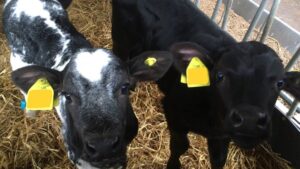MMN January 2024 – Selecting Beef Bulls for Use on Dairy
12 January 2024
Sales of sexed dairy semen are increasing year-on-year and have been reported by AHDB to have reached 76.5% out of all dairy semen sales in the 12-month period up to March 2023. As a result, not all pregnancies are needed to produce dairy replacements and therefore, unsurprisingly, there is an increase in the number of dairy-beef cross calves being produced. The logic behind this will be to produce a calf of a higher economic value to that of a dairy male calf.
There is now a growing interest in how to maximise the value of this dairy-beef cross calf further by using male sexed beef semen to produce a male beef cross calf rather than a female as, in general, the male beef cross calf will attract a higher price than a heifer beef cross calf. However, sexed male beef semen is perhaps not as widely available at present in comparison to sexed dairy semen (female).
Dairy farmers will have certain criteria which has swayed them to use specific dairy sires, but how much selection is made for which beef sire to use?
An area for consideration is breed – which beef breed to use? Looking at some recent auction prices for calves over the last couple of months, British Blue cross calves tend to command the highest prices. Data from AHDB on calf registrations for the first half of 2023 highlighted that there was a growth in the number of British Blue cross calves being born compared to the same period for 2022. Despite this, the data also showed a general trend towards an increase in the number of native beef breed calves (e.g. Aberdeen Angus X, Hereford X) and a reduction in continental beef breed calves (e.g. Limousin X, Simmental X). Much of these trends are a result of an increase in the uptake of integrated calf supply chains where breed of beef sire to use is stipulated. Also, native breeds are popular amongst retailers.
Which sire to use within a breed also needs careful consideration. Traits that merit attention are calving ease and gestation length. In the past, some beef breeds will have not been considered for use in dairy herds due to higher risk of difficult calvings. However, times have changed with many breeding organisations now actively marketing sires of those beef breeds based on their calving ease results from their calving surveys in dairy herds. Selecting sires based on a shorter gestation length usually produces a calf with lower birth weight and an easier calving. Thoughts should be given to the growth and carcase traits of beef sires as well. The major breeding organisations have developed their own indexes for beef sires used in dairy herds which take factors such as calving ease, gestation length and calf quality into consideration.
Many of the dairy-beef cross calves leave the dairy farm of birth within the first few weeks of life and are reared on another farm. If these calves are going to a regular buyer (not as part of an integrated supply chain), then it may be worth considering having a conversation with them about how your calves have performed in their system and look at the genetics of those calves that have performed well and think about using more of those beef sires.
David Bell, david.bell@sac.co.uk; 01387 263961
Sign up to the FAS newsletter
Receive updates on news, events and publications from Scotland’s Farm Advisory Service

